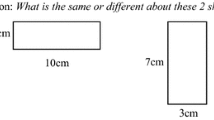Abstract
This article offers reflections on task design in the context of a Grade R (reception year) in-service numeracy project in South Africa. The research explores under what conditions, and for what learning purpose, a task designed by someone else may be recast and how varying given task specifications may support or inhibit learning, as a result of that recasting. This question is situated within a two-pronged task design challenge as to emerging gaps between the task designer’s intentions and teacher’s actions and secondly between the teachers’ intentions and students’ actions. Through analysing two teachers and their respective Grade R students’ interpretations of a worksheet task, provided to teachers in the project, we illuminate the way explicit constraints, in the form of task specifications, can be both enabling and constraining of learning. In so doing we recast this ‘double gap’ as enabling productive learning spaces for teacher educators, teachers and students.




Similar content being viewed by others
Notes
By Theo LeSieg & Roy McKie. Published by Beginner Books.
Dialogic reading involves multiple readings and conversations about books with strategic questioning and responding to children (Doyle and Bramwell 2006).
A similar book ‘5 children under umbrellas’ was later given to teachers hence the interchange in talk of trees and umbrellas.
References
Artigue, M., & Perrin-Glorian, M.-J. (1991). Didactic engineering, research and development tool: Some theoretical problems linked to this duality. For the Learning of Mathematics, 11(1), 3–17.
Bateson, G. (1979). Mind and Nature: A Necessary Unity (p. 2002). Cresskill: Hampton Press Inc.
Chevallard, Y. (1988). On didactic transposition theory: some introductory notes. Paper presented at the International Symposium on Research and Development in Mathematics Education, Bratislava, Czechoslovakia. Available online at http://yves.chevallard.free.fr/spip/spip/rubrique.php3?id_rubrique=6. Accessed 20 Aug 2012.
Coles, A. (2015). On enactivism and language: towards a methodology for studying talk in mathematics classrooms. ZDM, 47(2), 235–246.
Coles, A., & Brown, L. (2016). Task design for ways of working: making distinctions in teaching and learning mathematics. Journal of Mathematics Teacher Education, 19(2), 149–168.
Cuoco, A., Goldenburg, E., & Mark, J. (1996). Habits of mind: An organizing principle for mathematics curriculum. Journal of Mathematical Behavior, 15(4), 375–402.
DBE. (2011a). Action Plan to 2014: Towards the Realisation of Schooling 2025. DBE: Pretoria.
DBE. (2011b). National Curriculum Statement: Curriculum and Assessment Policy, Foundation Phase, Grade R. Mathematics. Pretoria: DBE.
DBE. (2014). Report on the Annual National Assessments. Pretoria: DBE.
DBRC. (2003). Design-based research: an emerging paradigm for educational inquiry. Educational Researcher, 32(1), 5–8.
Doyle, B., & Bramwell, W. (2006). Promoting emergent literacy and social–emotional learning through dialogic reading. The Reading Teacher, 59(6), 554–564.
Graven, M. (2014). Poverty, inequality and mathematics performance: the case of South Africa’s post-apartheid context. ZDM, 46, 1039–1049.
Graven, M. (2016). When systemic interventions get in the way of localized mathematics reform. For the Learning of Mathematics, 36(1), 8–13.
Graven, M., & Venkat, H. (Eds.). (2017). Improving primary mathematics education, teaching and learning: Research for development in in resource constrained contexts. Hampshire: Palgrave Macmillan.
Graven, M., Venkat, H., Westaway, L., & Tshesane, H. (2013). Place value without number sense: Exploring the need for mental mathematical skills assessment within the Annual National Assessments. South African Journal of Childhood Education, 3(2), 131–143.
Lyle, J. (2003). Stimulated recall: a report on its use in naturalistic research. British Education Research Journal, 29(6), 861–878.
Margolinas, C. (2005). Les situations à bifurcations multiples: indices de dysfonctionnement ou de cohérence. In A. Mercier & C. Margolinas (Eds.), Balises en didactique des mathématiques (pp. Cédérom). Grenoble La Pensée Sauvage.
Mason, J., Graham, A., & Johnston-Wilder, S. (2005). Developing thinking in algebra. London: Paul Chapman Publishing.
Maturana, H., & Varela, F. (1987). The tree of knowledge: the biological roots of human understanding. Boston: Shambala.
Maturana, H., & Verden-Zoller, G. (2008). The origin of humanness in the biology of love. Exeter. UK: Imprint Academic.
Reid, D. (1996). Enactivism as a methodology. In L. Puig & A. Gutierrez (Eds.), Proceedings of the twentieth annual conference of the International Group for the Psychology of Mathematics Education (Vol. 4, pp. 203–209). Valencia, Spain: PME 20.
Reid, D., & Mgombelo, J. (2015). Roots and key concepts in enactivist theory and methodology. ZDM, 47(2), 171–183.
Roberts, N. (2016). Telling and illustrating additive relation stories. Unpublished doctoral dissertation. University of the Witwatersrand.
Tahta, D. (1980). About geometry. For the Learning of Mathematics, 1(1), 2–9.
Takane, T., Tshesane, H., & Askew, M. (2017). Chapter 12: From Theory to practice: challenges in adopting pedagogies of mathematizing in South Africa. In M. Graven & H. Venkat (Eds.), Improving primary mathematics education, teaching and learning: Research for development in in resource constrained contexts (pp. 179–197). Hampshire: Palgrave Macmillan.
Thompson, E., & Stapleton, M. (2009). Making sense of sense-making: reflections on enactive and extended mind theories. Topoi, 28(1), 23–30.
Van den Heuvel-Panhuizen, M. (2003). The didactical use of models in realistic mathematics education: An example from a longitudinal trajectory on percentage. Educational Studies in Mathematics, 54(1), 9–35.
Watson, A., & Mason, J. (2007). Taken-as-shared: A review of common assumptions about mathematical tasks in teacher education. Journal of Mathematics Teacher Education, 10(4), 205–215.
Watson, A., & Ohtani, M. (2012). Task design in mathematics education discussion document. ICMI study 22 announcement and call for papers. http://ncm.gu.se/media/ncm/dokument/ICMI_Study_22_announcement_and_call_for_papers.pdf. Accessed 28 Oct 2014.
Weitz, M., & Venkat, H. (2013). Assessing early number learning†¯: How useful is the Annual National Assessment in Numeracy? Perspectives in Education, 31(3), 49–65.
Wright, R. J., Martland, J., Stafford, A. K., & Stanger, G. (2006). Teaching Number: Advancing children’s skills and strategies (2nd edn.). London: Paul Chapman Publishing Ltd.
Author information
Authors and Affiliations
Corresponding author
Rights and permissions
About this article
Cite this article
Graven, M., Coles, A. Resisting the desire for the unambiguous: productive gaps in researcher, teacher and student interpretations of a number story task. ZDM Mathematics Education 49, 881–893 (2017). https://doi.org/10.1007/s11858-017-0863-7
Accepted:
Published:
Issue Date:
DOI: https://doi.org/10.1007/s11858-017-0863-7




